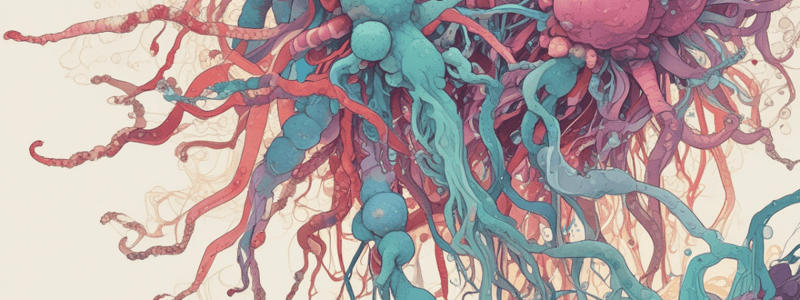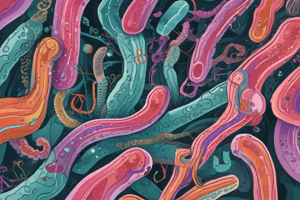Podcast
Questions and Answers
What type of toxins are highly antigenic proteins?
What type of toxins are highly antigenic proteins?
- Endotoxins
- Cell-surface toxins
- Intracellular toxins
- Exotoxins (correct)
How are exotoxins classified?
How are exotoxins classified?
- According to their mechanisms and targets (correct)
- According to their function
- According to their structure
- According to their molecular weight
What is the role of translocated toxins?
What is the role of translocated toxins?
- To penetrate the host cell
- To modulate the host cell metabolism (correct)
- To target the extracellular matrix
- To damage the cell membrane
What type of toxins includes T3SS toxins?
What type of toxins includes T3SS toxins?
What is the target of extracellular matrix toxins?
What is the target of extracellular matrix toxins?
What is the characteristic of AB toxins?
What is the characteristic of AB toxins?
What is the function of intracellular toxins?
What is the function of intracellular toxins?
What type of toxins targets the cell-surface?
What type of toxins targets the cell-surface?
How do exotoxins enter the host cell?
How do exotoxins enter the host cell?
What is the stage before the infection occurs?
What is the stage before the infection occurs?
What is the outcome of an infection where the individual is infected but does not show any symptoms?
What is the outcome of an infection where the individual is infected but does not show any symptoms?
What type of carrier is an individual who is recovering from the disease but still sheds the pathogen?
What type of carrier is an individual who is recovering from the disease but still sheds the pathogen?
What is the outcome of an infection where the individual is infected and shows symptoms, then recovers?
What is the outcome of an infection where the individual is infected and shows symptoms, then recovers?
What type of carrier is an individual who has recovered from the disease but still sheds the pathogen?
What type of carrier is an individual who has recovered from the disease but still sheds the pathogen?
What is the outcome of an infection where the individual is infected but does not show any symptoms and is a carrier?
What is the outcome of an infection where the individual is infected but does not show any symptoms and is a carrier?
What type of carrier is an individual who is incubating the pathogen but not yet ill?
What type of carrier is an individual who is incubating the pathogen but not yet ill?
What is the outcome of an infection where the individual is infected, shows symptoms, and then dies or becomes disabled?
What is the outcome of an infection where the individual is infected, shows symptoms, and then dies or becomes disabled?
What type of carrier is an individual who is infected with a clinical infection in a peracute, acute, or chronic phase?
What type of carrier is an individual who is infected with a clinical infection in a peracute, acute, or chronic phase?
What is the primary function of virulence factors in bacteria?
What is the primary function of virulence factors in bacteria?
Which of the following is NOT a function of surface-associated proteins?
Which of the following is NOT a function of surface-associated proteins?
What is the role of quorum-sensing in bacterial virulence?
What is the role of quorum-sensing in bacterial virulence?
What is the function of pili in bacterial virulence?
What is the function of pili in bacterial virulence?
How do efflux pumps contribute to bacterial virulence?
How do efflux pumps contribute to bacterial virulence?
What is the function of the capsule in bacterial virulence?
What is the function of the capsule in bacterial virulence?
What is the role of two-component systems in bacterial virulence?
What is the role of two-component systems in bacterial virulence?
What is the function of LPS in bacterial virulence?
What is the function of LPS in bacterial virulence?
What is the purpose of quorum-sensing in bacterial virulence?
What is the purpose of quorum-sensing in bacterial virulence?
What is the role of flagella in bacterial virulence?
What is the role of flagella in bacterial virulence?
What is the role of secretion systems in bacterial virulence?
What is the role of secretion systems in bacterial virulence?
What is the result of encapsulation in Streptococcus?
What is the result of encapsulation in Streptococcus?
What is the function of flagella in bacterial virulence?
What is the function of flagella in bacterial virulence?
What is the critical threshold concentration of pheromones required for quorum-sensing?
What is the critical threshold concentration of pheromones required for quorum-sensing?
What is the function of autoinducers in quorum-sensing?
What is the function of autoinducers in quorum-sensing?
What is the primary function of biofilms in terms of bacterial virulence?
What is the primary function of biofilms in terms of bacterial virulence?
Which of the following is a mechanism of transferring virulence factors between bacteria?
Which of the following is a mechanism of transferring virulence factors between bacteria?
What is the composition of the self-produced matrix in biofilms?
What is the composition of the self-produced matrix in biofilms?
What is a consequence of the transfer of virulence factors among bacteria?
What is a consequence of the transfer of virulence factors among bacteria?
What is the benefit of biofilms in terms of nutrient acquisition?
What is the benefit of biofilms in terms of nutrient acquisition?
What is the role of conjugation in the transfer of virulence factors?
What is the role of conjugation in the transfer of virulence factors?
What is the effect of biofilms on the interaction between bacteria and the host immune system?
What is the effect of biofilms on the interaction between bacteria and the host immune system?
What is the consequence of the selection of serious pathogenic strains in the clinic?
What is the consequence of the selection of serious pathogenic strains in the clinic?
What is the primary function of transformation in the transfer of virulence factors?
What is the primary function of transformation in the transfer of virulence factors?
What is the primary function of peptidoglycan in bacterial cell walls?
What is the primary function of peptidoglycan in bacterial cell walls?
Which type of fungal infection affects the lungs and other organs?
Which type of fungal infection affects the lungs and other organs?
What is the function of adhesins in bacterial virulence?
What is the function of adhesins in bacterial virulence?
What is the function of lipopolysaccharides in bacterial cell walls?
What is the function of lipopolysaccharides in bacterial cell walls?
What is the purpose of siderophores in bacterial iron acquisition?
What is the purpose of siderophores in bacterial iron acquisition?
Which of the following is NOT a type of fungal infection?
Which of the following is NOT a type of fungal infection?
What is the function of capsules in bacterial virulence?
What is the function of capsules in bacterial virulence?
What is a characteristic symptom of Toxic Shock Syndrome?
What is a characteristic symptom of Toxic Shock Syndrome?
What is the primary method by which bacteria acquire iron from the host?
What is the primary method by which bacteria acquire iron from the host?
Match to following to the correct Virulence factor.
Match to following to the correct Virulence factor.
Match the definition to the following term.
Match the definition to the following term.
Study Notes
Stages of Infection
- Exposure: the time period before infection, where the bacterium is shed by an individual
- Colonization: bacteria adhere to and multiply on a host surface
- Infection outcomes:
- No colonization
- Infection → disease → recovery
- Infection → subclinical disease (carrier state)
- Infection → disease → death/disability
- Infection → disease → persistence (carriers)
Disease Carriers
- Incubatory carrier: carrier that is incubating the pathogen but not yet ill
- Convalescent carrier: those who are recovering but continue shedding the pathogen
- Persistent carrier: the animal recovered from the disease but could not eradicate the pathogen
- Healthy carrier (subclinical): carrier state without clinical symptoms but shed the pathogen
- Clinical carrier: infectious animal with a clinical infection in a peracute, acute, or chronic phase
Virulence Factors
- Enable processes such as:
- Adhesion
- Biofilm formation
- Motility
- Toxin secretion
- Immune evasion
- Colonization
- Bacterial cell-cell communication
- Types of virulence factors:
- Surface-associated proteins
- Pili
- Flagella
- Efflux pumps
- Siderophore secretion
- Exotoxins
- Capsule
Highlighted Virulence Factors
- Exotoxins:
- Secreted by the bacteria
- Highly antigenic proteins
- Classified according to mechanisms and targets
- Can modulate host cell metabolism
- Capsule:
- Protects bacteria from the immune system
- Example: encapsulated strains of Streptococcus are more virulent than non-encapsulated strains
- Quorum-sensing:
- Regulation of gene expression in response to fluctuations in cell population density
- Mediated by chemical signal molecules (autoinducers)
- Flagella:
- Motility
- Adhesion
- Participates in biofilm formation
- Modulates the immune system of eukaryotic cells
- Biofilm:
- Clusters of bacteria attached to a surface and/or to each other and embedded in a self-produced matrix
- Functions:
- Protection from immune system
- Protection from desiccation
- Protection from antibiotics
- Improved acquisition of nutrients
- Improved bacterial-bacterial interactions
Transfer of Virulence Factors
- Methods of transfer:
- Transformation (acquiring free DNA from the environment)
- Transduction (bacteriophages transferring bacterial DNA)
- Conjugation (transfer of plasmids between bacteria)
- Implications:
- Emergence and dissemination of antimicrobial drug resistance
- Selection of serious pathogenic strains in the clinics
Toxic Shock Syndrome
- Caused by bacterial toxins, particularly TSST-1, produced by Staphylococcus aureus
- Characterized by fever, hypotension, rash, diarrhea, and mucous membrane involvement
- Typically affects menstruating women using tampons
- Can be fatal if left untreated
Iron Acquisition Mechanisms
- Bacteria require iron for growth and survival
- Siderophores are secreted molecules that chelate iron, allowing bacteria to scavenge iron from host
- Hemophores bind to hemoglobin and extract iron
- Direct uptake allows bacteria to take up iron directly from the host
Infectious Disease Pathophysiology
- Inoculation: pathogen enters the host
- Colonization: pathogen multiplies and establishes itself
- Invasion: pathogen penetrates host tissues
- Toxin production: pathogen produces toxins that cause harm
- Immune response: host responds to infection
- Disease: clinical symptoms manifest
Cell Wall Components
- Bacterial cell walls are composed of peptidoglycan (also known as murein), providing structural support
- Teichoic acids are found in Gram-positive bacteria and are involved in cell wall formation
- Lipoteichoic acids are found in Gram-positive bacteria and are involved in cell wall formation
- Lipopolysaccharides are found in Gram-negative bacteria and are involved in outer membrane structure
Fungal Infections
- Candidiasis is caused by Candida species and affects skin, mucous membranes, and internal organs
- Aspergillosis is caused by Aspergillus species and affects lungs and other organs
- Cryptococcosis is caused by Cryptococcus species and affects lungs and central nervous system
- Fungal infections often occur in immunocompromised individuals
Bacterial Virulence Factors
- Adhesins are molecules that facilitate bacterial attachment to host cells
- Invasins are molecules that facilitate bacterial invasion of host cells
- Toxins are molecules that harm host cells
- Capsules are polysaccharide layers that protect bacteria from host immune system
- Biofilms are complex communities of bacteria that resist host immune system and antimicrobial agents
Studying That Suits You
Use AI to generate personalized quizzes and flashcards to suit your learning preferences.
Related Documents
Description
This quiz covers the stages of bacterial infection, from exposure to infection outcomes, including colonization and disease. Test your knowledge of bacterial virulence and its effects.




